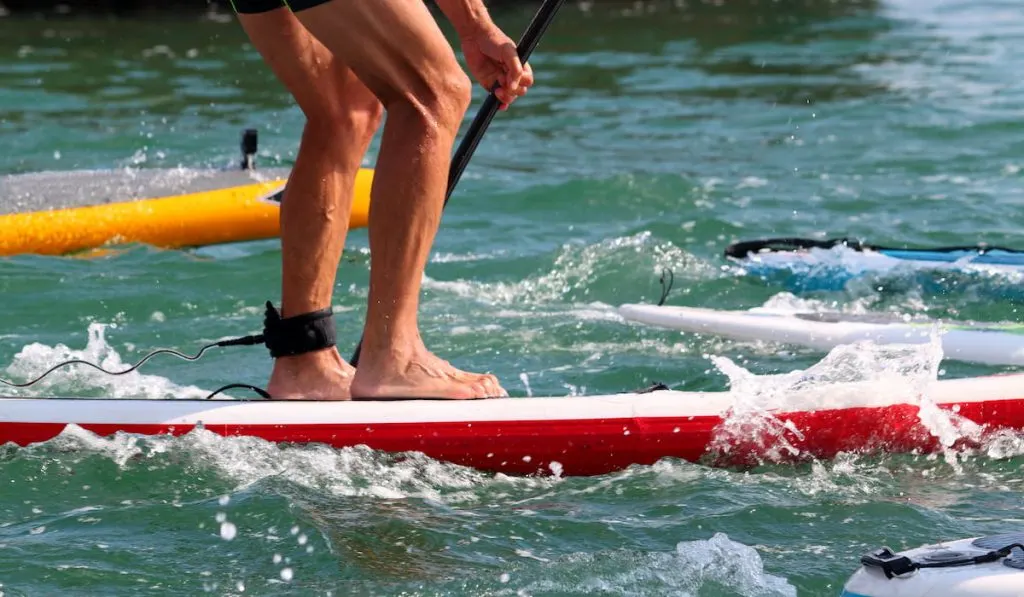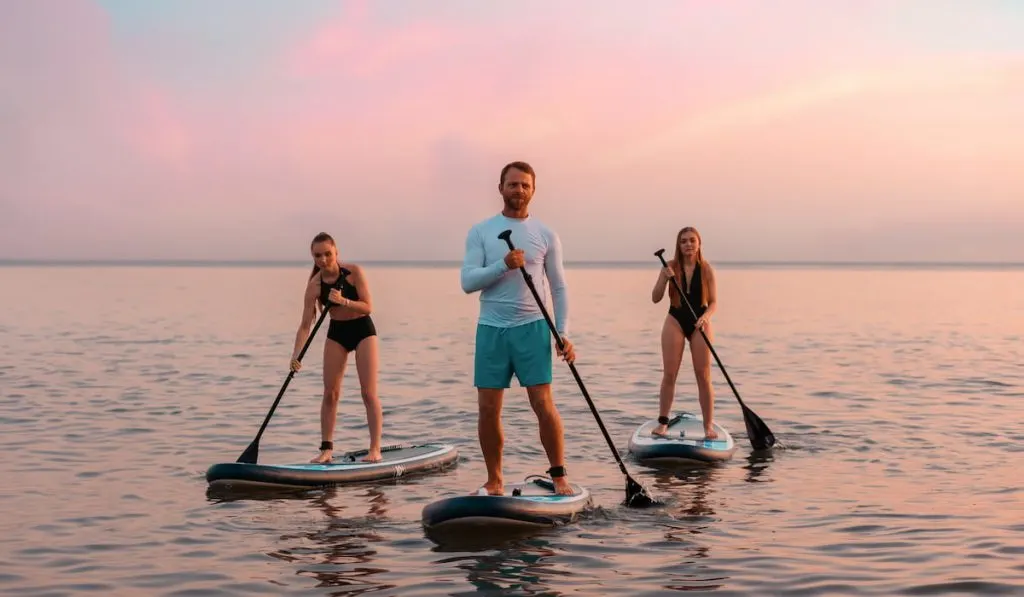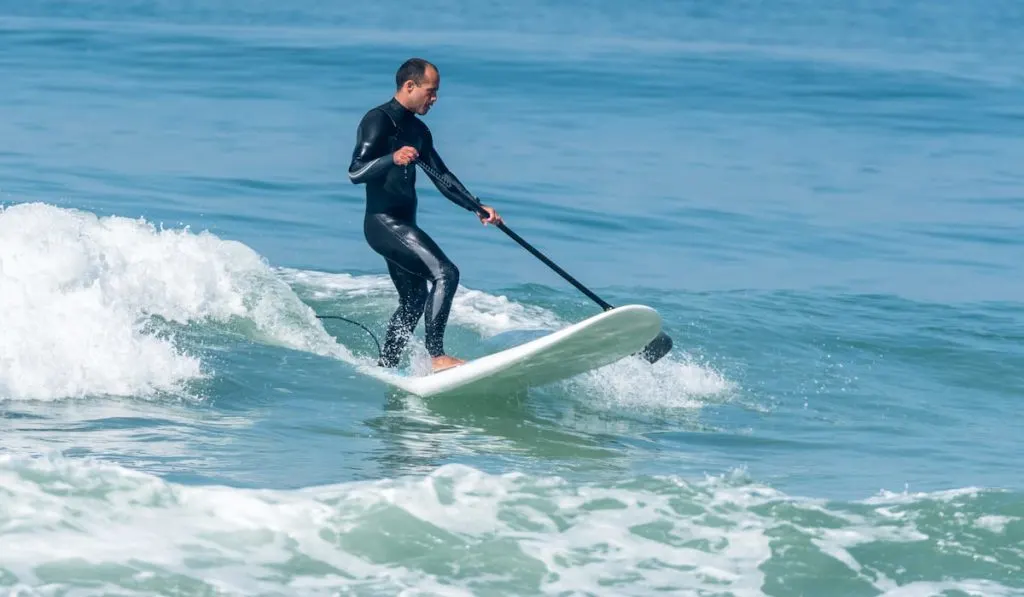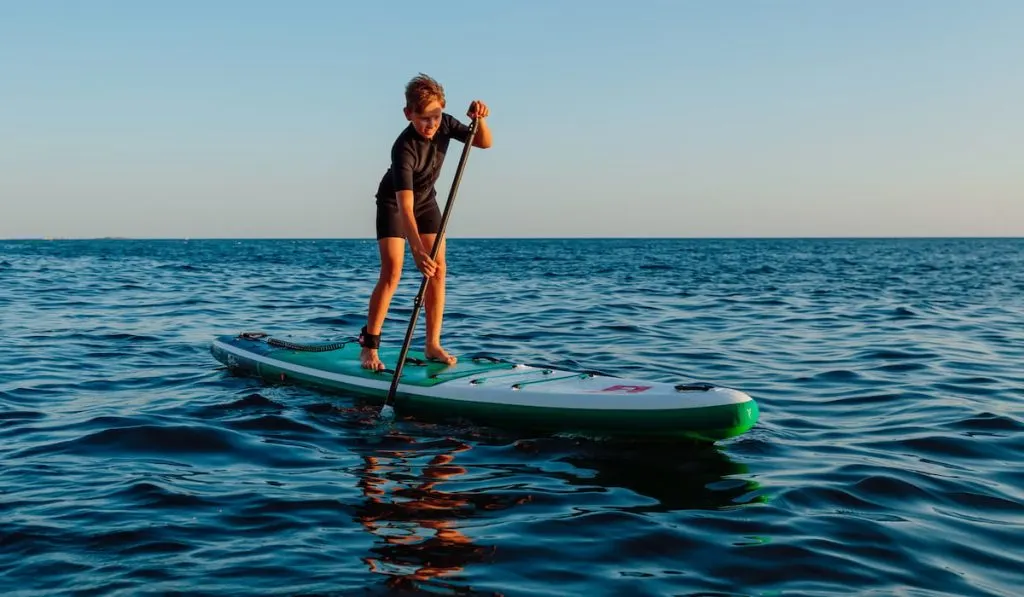Most sports and other types of physical activity usually have some element of danger involved. Life is about weighing your risks. You could, after all, twist your ankle badly coming down a flight of stairs. The threat of injury is small, though, so people keep walking.
Paddleboarding is a sport that’s growing in popularity every year. People naturally want to know whether it’s dangerous and if it’s something they can learn to tackle.
Stand-up paddleboarding has risks, just like other water sports, but they are relatively small as long as you practice safety precautions while you’re out in open water or around other people.
If you’re interested in trying to stand up paddleboarding, we’ve put together some of the risks you should be aware of and how you can mitigate them.
Let’s take a look at how you can safely learn and enjoy stand-up paddle boarding along with millions of other people around the world.

Learn the Risks
If you walk into any large sporting goods store, you’re probably going to find a section dedicated to paddleboarding. They even sell paddleboards in Costco these days.
The sport is incredibly popular. It’s great physical exercise, and people love the way they feel when they are out on the water.
Before you buy and get out there, though, it’s a good idea to familiarize yourself with the risk associated with stand-up paddleboarding, as well as some safety measures you can take to protect yourself and others.
Drowning
OK, let’s tackle the big one first. If you’re not a strong swimmer, then you should be cautious about stand-up paddleboarding anywhere with strong currents.
Everyone who tries stand-up paddleboarding should wear a life vest at all times, and you should be aware of water conditions wherever you are. If you’re new to the sport, start in places with calm waters and weak undercurrents.
You are going to fall off of the paddleboard, so you need to know how to swim and get back on. It’s a good idea to practice near the shore where you can still stand several times before you go out in deeper water. Just fall off and try getting back on again until you get the hang of it.
Bad Weather
Whether you’re paddleboarding or water skiing, you should always check the weather before you go out and avoid going out in poor weather conditions. Rain, winds, and storms can cause swells that make it harder to control the board and it can put you in danger.
Track the weather, and only go out when things are looking good. Good weather also helps you see the water clearly and avoid things like rocks and reefs that can injure you and damage your board.

Underwater Objects
When you’re stand-up paddleboarding, you’re not in the water, but unless you’re very experienced, you’re probably going to get wet. Knowing that you’re going to go in at some point, you should understand where you are paddleboarding and what’s under you at all times.
Let’s say you accidentally board over a reef and fall in. You may cut yourself and damage the reef. Both are unpleasant, so watch where you’re going to avoid rocks and other obstacles.
Hitting Other Boarders
If you’re paddleboarding in groups, staying too close together can be dangerous as well. Even experienced boarders will sometimes act erratically if they lose balance. The arms come up, and with that comes the paddles with sharp edges.
Plenty of people have had to get stitches after getting hit in the head with a paddleboard paddle. Keep proper distance and keep your paddles down when other people are close.
Other People on the Water
Chances are, even if you’re paddling by yourself, you’re not going to be alone on the water. This goes especially for people who stand up paddleboard on the ocean. There are boats, jet skis, surfers, and swimmers you have to deal with.
Stay aware of your surroundings at all times. If you can, wear bright clothing or buy a bright life vest that is easy for other people to spot. It’s hard to maneuver a paddleboard quickly, so keep your distance and react before you have to.

Rough Waters
People stand up paddleboard in lakes, oceans, and rivers. Rivers and oceans can be unpredictable. Rivers can be especially tricky because, depending on where you are, you have to navigate around rocks and rapids.
Sun Exposure
People sometimes overlook just how hard stand-up paddleboarding is. It’s an incredibly intense exercise, and the sport is often cited as one of the best ways to burn calories quickly.
When you’re out on your board, you’re burning energy and, usually, you’re completely exposed to the sun. That can lead to sunburn, heat exhaustion, and dehydration.
Do your best to always remember to bring water if you’re going on a long ride. Apply strong sunscreen before you go to limit sunburns, and wear a hat, sunglasses, and other gear to protect you from the sun.
If you’re new to paddleboarding, then take things slowly at first. Don’t go for hours at a time. Find out how much time your body needs to recover after you go and start building from there.
Sharks and Other Sea Creatures
People are understandably worried about shark attacks while they’re stand-up paddleboarding. Shark attacks do happen, but they are very rare.
If a shark does come close, they’re probably curious or have mistaken you for a seal or a dead whale that looks like an easy meal.
Most of the time, the sharks will hang around for a while and then leave. However, sharks have been known to swim up to paddleboards and take a chunk out of the board. Once they know it’s not food, they’ll give up.
Problems happen when people try to behave aggressively in an attempt to scare the sharks away. Instead of scaring the shark off, you’re probably going to end up in the water where you’re more at risk. The best thing you can do is stay calm and make your way to the shore.
There are also other animals in the ocean besides sharks. With a quick search on YouTube, you can see some amazing encounters that paddleboarders have with sea animals while they are out on the ocean.
You may have to deal with things like jellyfish too, so check your area and be aware of what’s around you.
Usually, authorities in your area will do a good job of listing things like shark sightings and other threats in the water that you can read about online before you go.

Losing Your Board
You can limit much of the danger around paddleboarding by always wearing a board leash. The board leash attaches to your ankle so that you’re never too far from your board if you fall off, which you eventually will. When you fall, your feet generally shoot the board in the other direction.
With no leash, it can end up dozens of feet or more away. You’re going to have to swim to get it, and you may have to swim in less than desirable conditions to retrieve your board.
Even though some boarders may feel like keeping the leash on is a bother, it will keep you safe so you can get back on your board faster.
Hypothermia
Remember, even if you’re a strong swimmer and you have all of the right gear on, you’re outdoors and are subject to changes in weather. Weather can make paddle boarding more dangerous for several reasons. If you’re in and out of the water and all you are wearing is a swimsuit, then you may start to get cold when you’re up and paddling.
That’s why a lot of paddlers, depending on where they live, go out in wetsuits. They keep them warm. You also have to consider that you may be out in deeper waters on the ocean when a storm comes in.
It may take you a good amount of time to make your way back to shore. Hypothermia can be a concern if you’re not appropriately geared up.
Stand Up Paddle Boarding Is Safe Despite All of This
Now that you know the risks of stand-up paddleboarding, it’s OK for us to tell you that it’s typically a very safe sport.
Accidents happen, but they are rare. You are much less likely to hurt yourself paddleboarding than, for example, jet skiing or surfing. There is risk in almost everything we do, but paddleboarding isn’t too high on the list.
Stay safe, practice proper precautions, track the weather, and avoid exposure to the sun and cold for too long.
Basically, don’t take any unnecessary chances, and you’ll be fine no matter where you go out. Now get out there and have some fun on your board!
